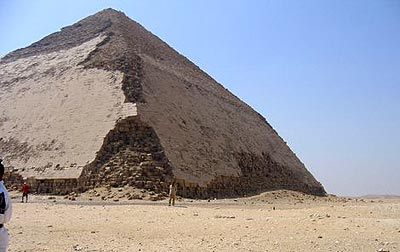CAIRO, EGYPT – In addition to my two Arabic classes, I also have a pass/fail third class entitled "History and Culture of Egypt." This course consists of weekly field trips to places of interest accompanied by explanations in Arabic - some of which I understand, and some of which I do not.
Apparently, they started the field-trip tradition last year and went to all the typical tourist spots: the Giza Pyramids, the Egyptian Museum, and Islamic Cairo. Then they realized that most people would go to those during their year here anyway. So, this summer we're taking the road less traveled - instead of the Giza Pyramids, we went to Dahshur and saw the Bent Pyramid and the Red Pyramid. This may sound blasphemous to some of you - I'm sorry, all you aspiring Indiana Joneses - but I think pyramids are kind of boring. Sometimes even painful. They all just seem like piles of old rocks to me.
The field trip started out from school, where the 40 or so CASA fellows plus several spouses and our two teachers climbed aboard a large, air-conditioned touring bus. We drove out of the city, following the path of the Nile. I was amazed at the views. The city landscape blends seamlessly into lush green fields that are farmed by hand, with picks and hoes or ploughs that oxen drag, rather than with tractors. One odd thing about farm life is that the farmers themselves live in half-finished-looking brick tenements adjoining the fields. They look very out of place, more like something that one would see in a city - not in the middle of a farm.
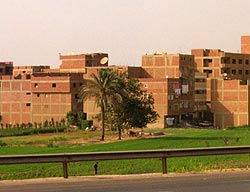 Farmworkers live in these strange windowless brick boxes near the fields. |
|
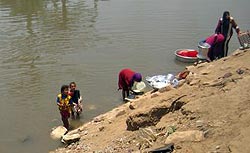 A multipurpose irrigation channel. |
|
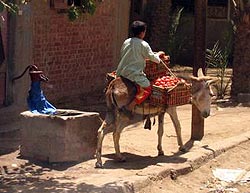 Taking the tomatoes to market. |
After driving through the tiny town of Dahshur and through a gate guarded by several military officers, we finally arrived at the pyramids. Our tour of the Bent Pyramid consisted of exiting the bus, walking partially around the outside of the thing in the broiling hot desert air while our teacher talked about the reason it was built crooked (apparently the engineer changed his mind on the slope halfway through construction), then getting back on the air-conditioned bus to drive over to the Red Pyramid, about half a mile away. I was not particularly impressed by the Bent Pyramid. This was revealed by the way that I kept referring to the pyramids as "mountains."
Maybe if I just go inside one, I'll be struck by the glory and the majesty of this ancient wonder, I thought.
I was wrong.
After a short talk about its dimensions and the construction, the teacher asked who would like to go inside the Red Pyramid. Without answering her, we all made a mad rush toward the stairway leading up the pyramid to a small passageway about halfway up the side. I hurried up the equivalent of about four flights of stairs, then began descending the 4-foot-wide, 4-foot-tall passageway that slopes a steep 63.2 meters through pitch darkness into the interior of the pyramid. The passage was just as hot as the exterior. There were numerous people behind me and in front of me, and I had to stoop at an odd angle and place my feet very carefully not to slip. The whole place smelled like some kind of evil mixture of human urine and cleaning solvents.
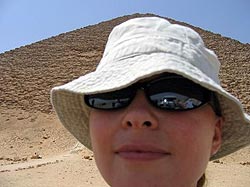 Me and the Red Pyramid. Did I mention it was really hot? |
|
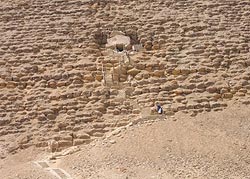 Hiking up to the Red Pyramid's entryway . |
|
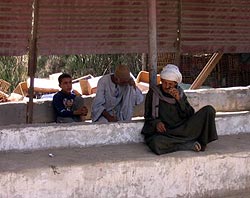 Villagers rest in the heat. |
Somehow, that got me to the bottom, where I looked at two big empty, smelly rooms and then climbed back out as quick as I could. My legs hurt for DAYS afterward. I made it back to the bus - hot, sweaty, and shaking - and declared that I would never enter a pyramid again.
On the way back out of town the bus stopped for 20 minutes so our guides could get water for all us poor whiteys (I am really not made for desert climes), and we got to watch the town go by around us. The life in Egypt's countryside is much different from life in the city, or from country life in America. Everyone rides donkeys around, walks out to the well to fill up their water cans, and seems to be busy at work on farm activities. Viewed from an air-conditioned bus window, it's quaint, but it's obviously a hard life. The farm towns are closer to the Nile and lush with vegetation, but at their outskirts, the desert begins and the heat is just abominable.
After several more hours on the bus, we arrived in Fayyoum, the region where organized agriculture in Egypt began. People started here, relying on Bahr Yusif for irrigation, then later migrated to the Nile Delta region. The area is still famous for farming, though we just saw that aspect only from the windows. Instead, the bus took us to a rather fancy restaurant for lunch, where the meat-eaters got a big plate of rice with an enormous portion of chicken, and the vegetarians got two plates full of food: one of just spaghetti, and another of roasted eggplant, french fries, and steamed veggies. Strange, but all vegan friendly. I was delighted.
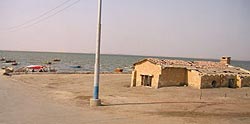 Bahr Yusif, an enormous lake in Fayyoum, mysteriously seems to be submerging nearby buildings in sand. |
|
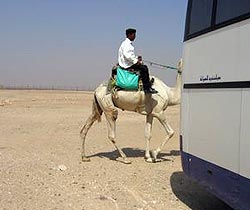 A shy camel cop. |
As we gazed at the lake, children tried to sell us shell necklaces and baskets, but our armed police escort shooed them away. Yes, we had a police escort. They drove a police car behind the bus throughout the trip and would sound its siren anytime someone didn't get out of the bus's path quickly enough. And they carried guns. Big guns.
Next week we have another desert field trip to a monastery and a farm in the Sahara. I think they are punishing us. Thank goodness I brought so much sunscreen!
—Pamila
Pamila Pengra graduated from UC Berkeley in May 2005 with a B.A. in linguistics. She is studying Arabic in Cairo on a CASA fellowship.





